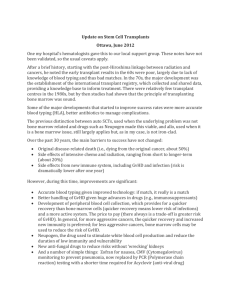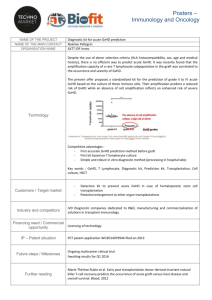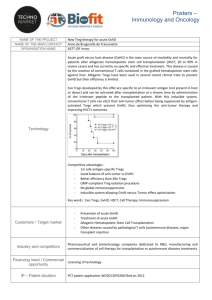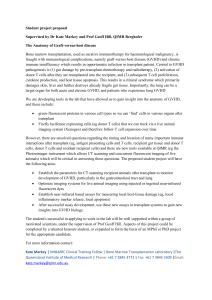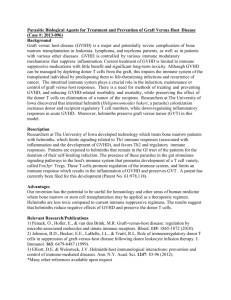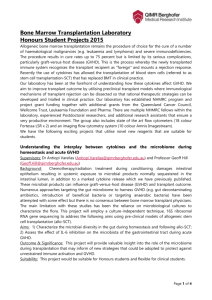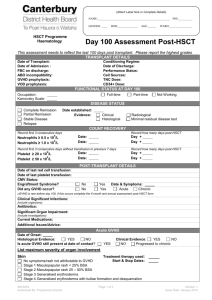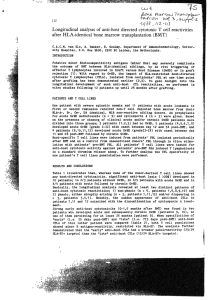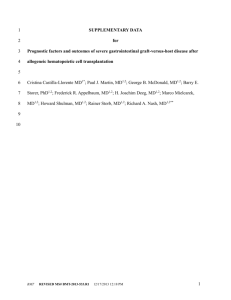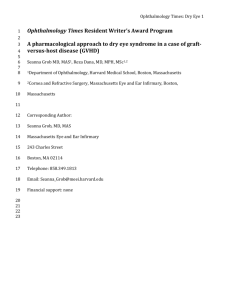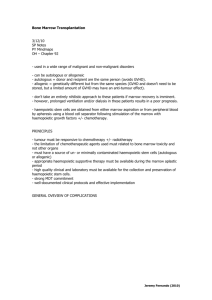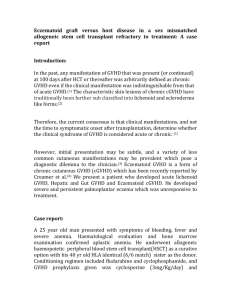Available projects and contact details
advertisement
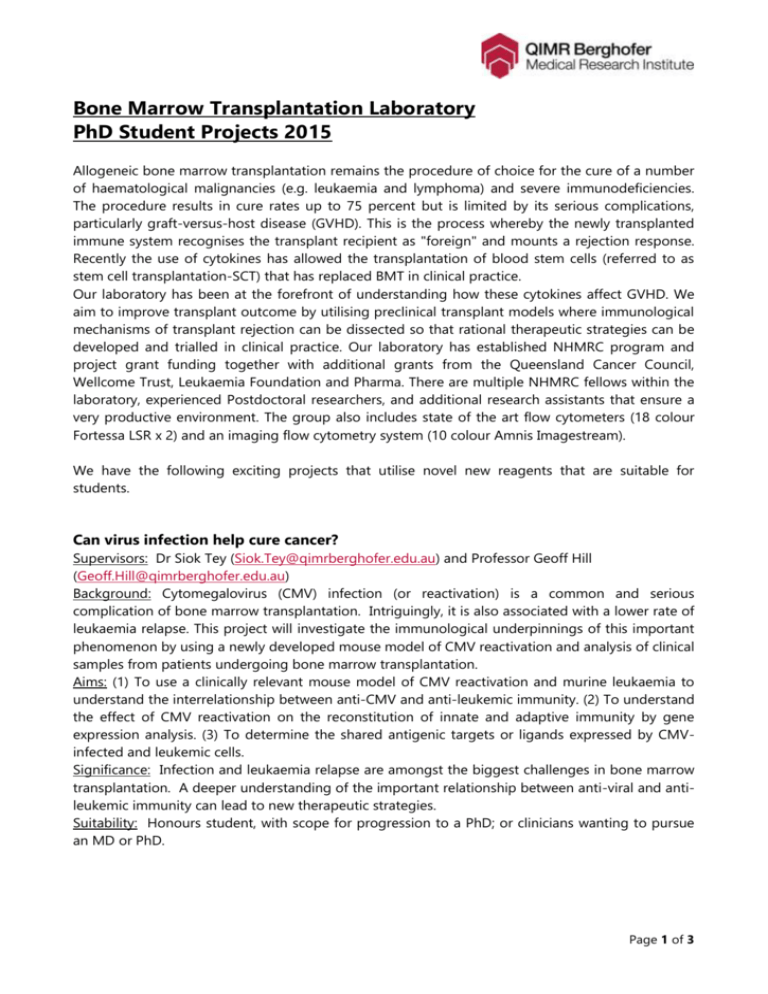
Bone Marrow Transplantation Laboratory PhD Student Projects 2015 Allogeneic bone marrow transplantation remains the procedure of choice for the cure of a number of haematological malignancies (e.g. leukaemia and lymphoma) and severe immunodeficiencies. The procedure results in cure rates up to 75 percent but is limited by its serious complications, particularly graft-versus-host disease (GVHD). This is the process whereby the newly transplanted immune system recognises the transplant recipient as "foreign" and mounts a rejection response. Recently the use of cytokines has allowed the transplantation of blood stem cells (referred to as stem cell transplantation-SCT) that has replaced BMT in clinical practice. Our laboratory has been at the forefront of understanding how these cytokines affect GVHD. We aim to improve transplant outcome by utilising preclinical transplant models where immunological mechanisms of transplant rejection can be dissected so that rational therapeutic strategies can be developed and trialled in clinical practice. Our laboratory has established NHMRC program and project grant funding together with additional grants from the Queensland Cancer Council, Wellcome Trust, Leukaemia Foundation and Pharma. There are multiple NHMRC fellows within the laboratory, experienced Postdoctoral researchers, and additional research assistants that ensure a very productive environment. The group also includes state of the art flow cytometers (18 colour Fortessa LSR x 2) and an imaging flow cytometry system (10 colour Amnis Imagestream). We have the following exciting projects that utilise novel new reagents that are suitable for students. Can virus infection help cure cancer? Supervisors: Dr Siok Tey (Siok.Tey@qimrberghofer.edu.au) and Professor Geoff Hill (Geoff.Hill@qimrberghofer.edu.au) Background: Cytomegalovirus (CMV) infection (or reactivation) is a common and serious complication of bone marrow transplantation. Intriguingly, it is also associated with a lower rate of leukaemia relapse. This project will investigate the immunological underpinnings of this important phenomenon by using a newly developed mouse model of CMV reactivation and analysis of clinical samples from patients undergoing bone marrow transplantation. Aims: (1) To use a clinically relevant mouse model of CMV reactivation and murine leukaemia to understand the interrelationship between anti-CMV and anti-leukemic immunity. (2) To understand the effect of CMV reactivation on the reconstitution of innate and adaptive immunity by gene expression analysis. (3) To determine the shared antigenic targets or ligands expressed by CMVinfected and leukemic cells. Significance: Infection and leukaemia relapse are amongst the biggest challenges in bone marrow transplantation. A deeper understanding of the important relationship between anti-viral and antileukemic immunity can lead to new therapeutic strategies. Suitability: Honours student, with scope for progression to a PhD; or clinicians wanting to pursue an MD or PhD. Page 1 of 3 Characterising miRNA expression after bone marrow transplantation to develop novel therapeutics Supervisors: Dr Kate Gartlan (Kate.Gartlan@qimrberghofer.edu.au) and Professor Geoff Hill (Geoff.Hill@qimrberghofer.edu.au) Background: Micro RNAs (miRNAs) are small RNA molecules (~25 nucleotides) known to play an important role in regulating inflammation. Therefore miRNA may be a novel target to treat inflammatory diseases such as graft-versus-host disease (GVHD). GVHD develops in >50% of leukaemia patients that receive a donor stem cell/bone marrow transplant (SCT/BMT). GVHD has a major impact on the mortality and quality-of-life for these cancer survivors, however treatment options are very limited and steroid refractory GVHD patients (~20%) have particularly high mortality rates. Unfortunately, GVHD severity and tumour clearance are positively correlated, which means a balance must be struck between providing anti-tumour immunity and reducing the risks associated with GVHD. Our laboratory is therefore investigating novel therapeutics such as miRNAs to modulate inflammatory responses after BMT/SCT. Aims: We are currently offering a project designed to 1) characterise miRNA expression profiles in patient serum after BMT/SCT and 2) to evaluate potential inflammatory biomarkers of GVHD. Significance: New therapies are urgently needed to minimise the effects of GVHD after donor SCT/BMT. This project will use molecular and cell biology techniques and clinical samples to identify potential new targets for GVHD immunotherapy. Suitability: This project would suit either Honours or PhD students. What is the influence of infection driven T cell polarisation on graft-versus-host disease? Supervisors: Dr Kate Gartlan (Kate.Gartlan@qimrberghofer.edu.au) and Professor Geoff Hill (Geoff.Hill@qimrberghofer.edu.au) Background: Stem cell/bone marrow transplantation (SCT/BMT) is an important curative therapy for haematological malignancies and disorders; however graft-versus-host disease (GVHD) and infection are two major complications of this procedure. Whilst it is well established that viral and bacterial infections influence GVHD pathogenesis, the impact of fungal infection after transplant is poorly understood. In non-transplant settings, adaptive immune responses to fungal infections are commonly associated with IL-17 production by T cells that enhance anti-fungal immunity. However our laboratory and others have demonstrated that the IL-17 differentiation pathway is pathogenic in the context of allotransplantation. We are offering a project designed to understand the relationship between fungal infection and GVHD outcomes. Aims: This project will 1) establish an in vivo infection model that can be used in conjunction with bone marrow transplant in pre-clinical experimental system, and 2) explore the relationship between fungal infection, T cell polarisation and GVHD. Significance: Once established, this model will be the first of its kind and will be an important tool to examine the influence of infection on inflammatory disease pathology. Suitability: This project would suit a PhD student. Page 2 of 3 Modulating donor T cell polarisation after bone marrow transplantation to prevent graft-versus-host disease Supervisors: Dr Kate Gartlan (Kate.Gartlan@qimrberghofer.edu.au) and Professor Geoff Hill (Geoff.Hill@qimrberghofer.edu.au) Background: Stem cell transplantation (SCT) is an effective cancer treatment, however its application is limited by graft-versus-host disease (GVHD), which has a major impact on patient morbidity and mortality. Unfortunately, GVHD severity and tumour clearance are positively correlated and therefore new therapies designed to reduce GVHD must be targeted, such that antitumour immunity is maintained. Donor T cell polarization is a critical factor influencing the severity and tissue distribution of graft-versus-host disease (GVHD) and the potency of graft-versusleukaemia (GVL) effects after allo-SCT. We have identified a pathogenic donor T cell differentiation program that exacerbates GVHD without contributing to tumour clearance, which is characterised by a unique transcription factor expression profile. Aims: This study will 1) examine T cell transcription factor expression after allo-SCT in both murine and clinical samples, and 2) utilise a small molecule inhibitor that modulates transcription factor expression to assess its therapeutic potential in the context of GVHD. Significance: This therapeutic approach is highly novel and will provide the first essential proof-ofconcept data to support small molecule modulation of T cell polarisation as a method for GVHD prevention and treatment. Suitability: This project would suit either Honours or PhD students. For more information about these projects, please contact the supervisors listed with each project. http://www.qimrberghofer.edu.au/page/Lab/Bone_Marrow_Transplantation/ Page 3 of 3
